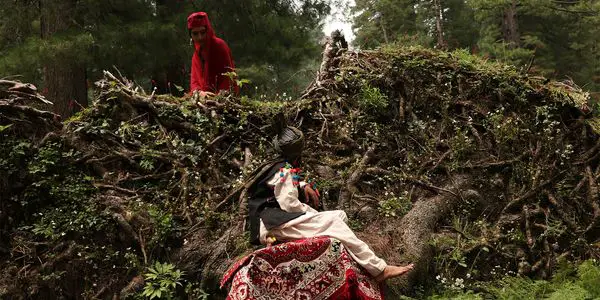THE SHEPHERDESS & THE SEVEN SONGS: A Dance Of History And Cultures Past

Soham Gadre is a writer/filmmaker in the Washington D.C. area.…
Stringing together multiple sources and influences, Pushpendra Singh’s The Shepherdess and the Seven Songs (original title: Laila aur Satt Geet) is a spellbinding dance between Kashmir’s folkloric past and its tumultuous present. Taking place in Jammu & Kashmir, a region that has been under dispute and the catalyst of multiple military conflicts and ongoing communal violence for some time, there is an undercurrent within the glorious panoramas of this film of a dark and wounded land. It’s a tragic irony of this region at the foothills of the Himalayas that it is both stunningly beautiful and also conflicted. Such is also the central character of Singh’s film, Laila, portrayed brilliantly by Manjot Randhawa.
Laila & Kashmir
Randhawa‘s Laila is coy and standoffish. She makes one recall Mita Vashist’s character Tejo from Kumar Shahani’s Kasba (1989) – a subtly conniving personality tricking the men (and women) surrounding her out of self-protection and gain. But Laila is more well-intentioned and insular in her actions, which lie more in self-defense. The police commissioner (Ranjit Khajuria) and his lackey Mushtaq (Shahnawaz Bhat) both fall for Laila’s stunning beauty but when she rebuffs them, they only take it as a signal to try even harder. The commissioner wants to resort to force and assault but his lackey, who may truly be in love, tries to covertly get her to meet him in a secluded area. At night as the lackey waits for her, Laila brings her husband Tanvir (Sadakkit Bijran) along telling him that someone is robbing their sheep.

Laila’s self-preservation, her beauty that enchants nearly every man she meets, and the anger and desire of others is a striking metaphor for Kashmir’s history in the Indian Subcontinent. Singh’s film is steeped in traditional ways of life and highlighted by moments of mysticism, but modern politics and warfare rumble the tranquil proceedings often. The first ten minutes of the movie could take place at any point in the last 500 years but it’s only once the nomadic Bakarwal tribe’s pilgrimage (they make annual treks from the Hindu Kush in Afghanistan to Ladakh in Kashmir) to a new land takes them across a steel bridge do we realize we are in the present day.
A Small Story Hidden in the Mountains
Pushpendra Singh is an early collaborator with Indian experimental auteur Amit Dutta, having acted in Dutta’s first two features Nainsukh (2010) and Aadmi ki Aurat aur Anya Kahaniyaan (2009). Dutta’s style has some DNA in Shepherdess, particularly in the way Singh distorts the geometry of disconnected spaces, having corners and obstacles feel like they’re jutting out at the camera. People are either separated or crowded by interior spaces – sometimes split by the middle divider of a windowsill, or packed together in a door frame. Architecture is a disruptor to the tranquility of the Himalayan foothills.

Singh and his DP Ranabir Das (for who this is his debut feature) create a stark contrast of people and surroundings, especially in the mountains. Like many stories steeped in folklore, the community and the individuals by the contrast of the greater world are small and insular. It brings to the forefront the minuscule scope of people and stories in the grander canvasses of nature and time.
Conclusion:
Singh’s influences from Rajasthani author Vijaydan Detha (perhaps most famous for the short story Duvidha which was adapted by Mani Kaul into a masterpiece film of the same name), as well as the 14th-century mystic poet Lalleshwari, blur time and history. The conscious persistence of ancient customs in a modern, tumultuous Kashmir, one where violence and danger are just out of the frame, centers the history of the region as one where the past and present clash constantly.
What did you think? Let us know in the comments below!
The Shepherdess and the Seven Songs was released on VOD streaming via Grasshopper Films in the U.S. on March 19th, 2022
Watch The Shepherdess and the Seven Songs
Does content like this matter to you?
Become a Member and support film journalism. Unlock access to all of Film Inquiry`s great articles. Join a community of like-minded readers who are passionate about cinema - get access to our private members Network, give back to independent filmmakers, and more.
Soham Gadre is a writer/filmmaker in the Washington D.C. area. He has written for Hyperallergic, MUBI Notebook, Popula, Vague Visages, and Bustle among others. He also works full-time for an environmental non-profit and is a screener for the Environmental Film Festival. Outside of film, he is a Chicago Bulls fan and frequenter of gastropubs.













